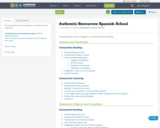
These authentic resources support a unit about school in Spanish.
- Subject:
- Arts and Humanities
- Material Type:
- Teaching/Learning Strategy
- Date Added:
- 07/17/2018

These authentic resources support a unit about school in Spanish.
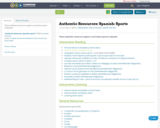
These authentic resources support a unit about sports in Spanish.
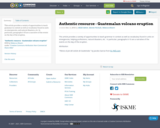
This article provides a variety of opportunities to teach grammar in context as well as vocabulary found in units on emergencies, and natural disasters, etc. In particular, paragraphs 6-10 are a narrative of the events on the day of the eruption.

This is the story of the Aztec’s historic 200+ year pilgrimage, as told from the 16th Century Primary source: The Codex Boturini.
The Aztecs came from a place in the north called: Aztlan, which means, “place of the White Heron.”
The Aztecs left their homeland Aztlan in about 1111 C.E. After more than 200 years of trials and tribulations, they stopped when they saw their sign from their god Huitzilopochtli: the eagle perched on the cactus. There, they would build one of the greatest cities in world history.
This is the story of their historic migration from Aztlan to Tenochtitlan in their own words.
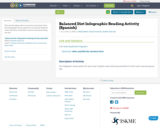
This activity aligns with a novice-level unit about food. The infographic shows options for each meal. Students select what they would like to eat for each meal during one day.

Short Description:
Basic Spanish Language and Culture is a text that provides a step-by-step introduction to the elementary concepts of Spanish Grammar and builds on this knowledge to create a fun learning environment for Writing/Reading and Listening/Speaking. It includes a fun and agile description of the phonetics of Spanish and several engaging and dynamic pronunciation exercises to go with it.
Long Description:
Basic Spanish Language and Culture is a text that provides a step-by-step introduction to the elementary concepts of Spanish Grammar and builds on this knowledge to create a fun learning environment for Writing/Reading and Listening/Speaking. It combines detailed analysis and review of the different tenses of Spanish in a Comparative approach with the structures of English. And, for the first time in resources of this type, it includes a fun and agile description of the phonetics of Spanish and several engaging and dynamic pronunciation exercises to go with it.
Each Unit will help the student acquire a working mastery of the main tenses involved in the production of correct Spanish sentences in both academic and informal settings. The content of the text invites to constant reinforcement of the knowledge acquired in the classroom, with ample opportunities to further develop the different elements that are dealt with during the synchronous and in-person sessions throughout the semester.
Bienvenido al mundo del Español! Welcome to the World of Spanish!
Word Count: 12165
(Note: This resource's metadata has been created automatically by reformatting and/or combining the information that the author initially provided as part of a bulk import process.)
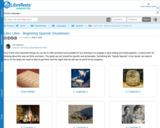
This is an OER textbook developed by Erin Huebener at Spokane Community College.
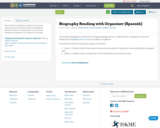
This activity is designed for advanced or heritage language learners. Students select a biography of personal interest from biografiascortas.com and complete an organizer. Two options are included.
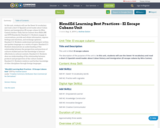
In this unit, students will use the Sweet 16 vocabulary and read a short CI Spanish novel/reader about Cuban history and immigration (El escape cubano by Mira Canion)
Author: Kelly Garcia
Content Area Skills (NE and ISTE Standards):
Standard 1.1: Students engage in conversations, provide and obtain information, express feelings and emotions, and exchange opinions.
Standard 1.2: Students understand and interpret written and spoken language on a variety of topics.
Standard 2.1: Students demonstrate an understanding of the relationship between the perspectives and practices of cultures studied and use this knowledge to interact effectively in cultural contexts.
Standard 2.2: Students show an understanding of the relationship between products and perspectives of the culture studied.
Standard 3.1: Students reinforce and further knowledge of other disciplines through foreign languages.
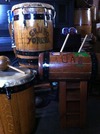
Students will investigate musical genres in Spanish Speaking countries in order to better understand the history and influences that created the music, as well as the cultural connections/impact of the music today. Begin studying Bomba as a class and work through the investigation process together; then students can select a different genre of music to research and explore before creating a visual essay about their topic.The complete lesson plan included is the 4th class period of a 8-10 period unit of study; the complete unit slides are included in the resource folder with all readings, videos, etc. Lessons are in Spanish, but could be adapted for an English class with Spanish translanguaging as many of the videos are included with closed captions.
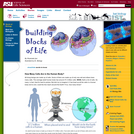
All living beings are made up of cells. Some of them are made up of only one cell and others have many cells. Also in: Dutch | French | Hungarian | Spanish
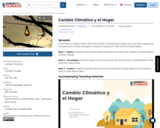
SYNOPSIS: In this lesson, students learn about the impact of household energy use on climate change and compare and contrast strategies to reduce emissions in Chile and the United States.
SCIENTIST NOTES: Energy-efficient homes are an important part of solving the climate crisis, as this lesson explains. This lesson shows how Chile is planning to make homes more energy efficient. This lesson passed the scientific review process.
Los hogares energéticamente eficientes son una parte importante de la solución de la crisis climática, como se explica en esta lección. Esta lección muestra cómo Chile está planeando hacer que los hogares más eficientes energéticamente. Esta lección pasó el proceso de revisión científica.
POSITIVES:
-Students immerse in authentic Spanish language audiovisual resources and explore cultural perspectives in addition to learning about climate change.
-The lesson includes many hands-on and communicative activities.
-Teachers can customize the lesson by selecting activities from each section that best fit their class.
ADDITIONAL PREREQUISITES:
-Students should be familiar with numbers, weather, some geographical features, parts of a house, and household activities prior to this lesson.
-Students should have basic skills in the present tense to describe a place in a house and be able to ask and answer questions about daily activities.
-The card game in the Investigate section requires a set of cards for every 4-5 students to be printed, cut, and pasted onto a sturdy backing.
-The communicative game in the Inspire section requires a die or set of dice for each pair of students.
DIFFERENTIATION:
-Students can watch the videos as a class, in pairs, or individually.
-Novice students can focus on describing what they see in the videos using familiar vocabulary and can use the English language version of the EPA website.
-Novice-high and Intermediate-low students can engage with the spoken and written messages in the videos and use the Spanish language version of the EPA website.

COERLL produces online language learning materials (for example language courses, reference grammars, assessment tools, and corpora) for teachers to adopt, adapt, modify, and share, and also provides professional development tools for teachers. You can browse materials on the COERLL website.
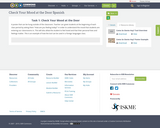
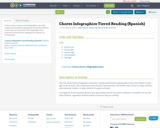
In this activity, students read infographics and other reading material about appropriate chores that children of each age can do at home. The complexity of the resources varies by level, ranging from beginner to intermediate.
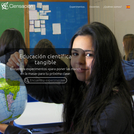
Ciensación fue creado con el apoyo de UNESCO Brasil para promover una cultura de experimentos cortos «para poner las manos en la masa» y una educación científica que estimule el desarrollo de habilidades.
El sitio web es un compilado de REA con actividades cortas de investigación —se llevan a cabo en menos de 10 minutos— que pueden incorporarse con facilidad a la enseñanza del día a día en las clases regulares. En vez de simplemente ilustrar conceptos científicos o fenómenos naturales, estos experimentos prácticos traen preguntas para que los alumnos se involucren en debates sobre la búsqueda de evidencias. Fueron elaborados para estimular el pensamiento crítico y las mentes curiosas y para que los alumnos sientan el placer de descubrir. En otras palabras: para enseñar ciencias como una actividad, como un arte fascinante que los alumnos querrán dominar.
Los docentes están invitados a publicar sus propios experimentos para «poner las manos en la masa» en Ciensación. Los experimentos enviados que pasen el proceso de revisión serán publicados como REA en portugués, español e inglés, bajo la licencia internacional Creative Commons Attribution-ShareAlike 4.0.

Este curso busca resignificar los prejuicios de género que se encuentran en el tema del color. Está enfocado en alumnos de kínder en un rango de edades de los 4 a los 6, con actividades creativas e interactivas que buscan tener como resultado la desmitificación de que los colores (principalmente el rosa y el azul) tienen género. Nota: este curso ocupa materiales adicionales como lo son impresiones que se recomienda se tomen en cuenta para la realización del mismo.
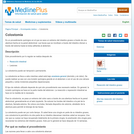
This patient education program explains colostomy and ileostomy and requisite postoperative care. This is a MedlinePlus Interactive Health Tutorial from the National Library of Medicine, designed and developed by the Patient Education Institute.
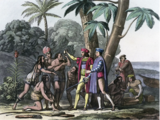
Modificado y traducido de la adaptación de Rebecca Stefoff de La otra historia de los estados unidos escrito por Howard Zinn

This activity is designed to introduce novice-level unit about clothing and shopping. Students use the website for El Corte Inglés (a department store in Spain) to discover clothing vocabulary and shop for clothing.